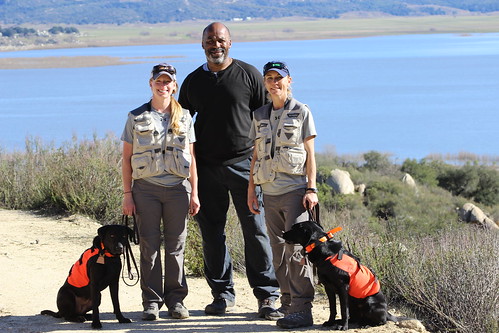
The National Feral Swine Damage Management Program, within the USDA’s Animal and Plant Health Inspection Service’s Wildlife Services (WS) program, has unleashed detector dogs as a new tool to help stop the spread of feral swine, one of the United States’ most destructive and ravenous invasive creatures.
WS first used detector dogs in 2013, to successfully sniff out the scat or droppings of invasive Nutria on Maryland’s Lower Eastern Shore as part of the Chesapeake Bay Nutria Eradication Program (CBNEP), a multifaceted effort to rid the area of the damaging animal. Applying the same training techniques, the dog handlers from the Nutria program were able to cross train the canines to locate and detect feral swine scat. WS field staff from across the country sent in samples of feral swine scat so the dogs could be trained to detect it.
Recently, two dogs, along with their handlers, had the opportunity to put this new training into action when they were flown to the San Diego area. Experts believed feral swine were eradicated in the area, but needed to dogs’ help to help prove the animal’s absence.
“The dogs did not have any confirmed detections,” said Marnie Pepper, a certified biologist and WS project leader for the Chesapeake Bay Nutria Eradication Project/Nutria Detector Dog Program. “One dog, Keeva, did respond and that sample was collected. But the DNA was so compromised that they could not come back with a clear yes or no about the identity of the animal.”
This is a new tool, and WS will continue to train the dogs and use them to detect nutria, feral swine, and possibly other invasive species, in the future.
“It’s hard to prove that an animal isn’t in an area,” said Dr. Dale Nolte, head of the National Feral Swine Damage Management Team. “The detector dogs give us that confidence so we can say they are gone and focus on other areas that are still experiencing damage.”
Feral swine, decedents of released or escaped domestic pigs, have taken hold in North America, and their range has expanded over the last few decades because they are highly adaptable, lack natural predators and have been translocated to new areas by people. Damage management operations vary depending on the location and type of damage.
Feral swine are a risk to human and domestic animal health, harm threatened and endangered species, hurt native wildlife and natural resources, uproot crops, damage yards, ruin golf courses, threaten water quality, and are generally considered the worst invasive species on earth. A group of feral swine can overturn acres of land in a single night, rooting with their snouts and tusks. They eat anything they can find, including salamanders, insects, frogs, and the eggs of ground nesting birds, reptiles, and amphibians. Additionally, they are prolific breeders, with more than an estimated 6 million feral swine in at least 35 states, inflicting about $1.5 billion dollars in damage each year.
The USDA is working across the country to assess, control, and prevent feral swine damage. Dogs are just one of the many tools the USDA is using to stop feral swine, but if you see feral swine or their damage on your property contact USDA for assistance. To learn more about feral swine, call 1-866-4-USDA-WS or read about them on the APHIS website.


